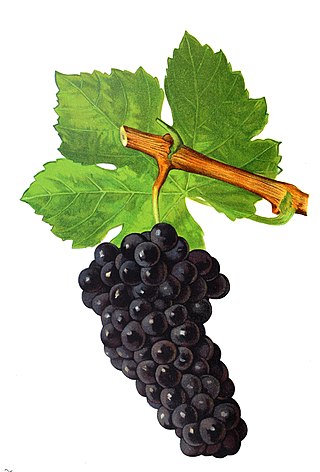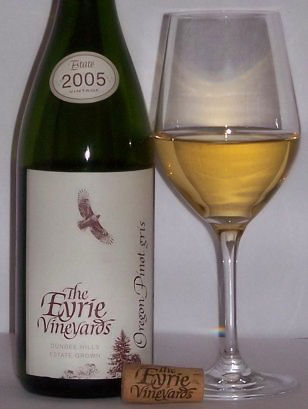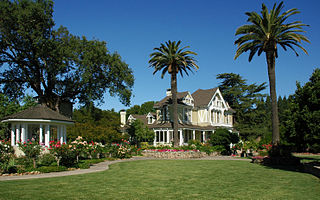
Sparkling wine is a wine with significant levels of carbon dioxide in it, making it fizzy. While it is common to refer to this as champagne, European Union countries legally reserve that word for products exclusively produced in the Champagne region of France. Sparkling wine is usually either white or rosé, but there are examples of red sparkling wines such as the Italian Brachetto, Bonarda and Lambrusco, and the Australian sparkling Shiraz. The sweetness of sparkling wine can range from very dry brut styles to sweeter doux varieties.

Boxed wine is a wine sold in "bag-in-box" packaging. Traditionally, this consists of a cardboard box containing a wine filled plastic reservoir. The flow of the wine from the box is controlled by a valve.

Durif is a variety of red wine grape primarily grown in Australia, California, France, and Israel. Since the end of the 20th century, wineries located in Washington's Yakima River Valley, Maryland, Arizona, Texas, West Virginia, Chile, Mexico's Baja California Peninsula, and Ontario's Niagara Peninsula have also produced wines from Durif grapes. It is the main grape known in the U.S. and Israel as Petite Sirah, with over 90% of the California plantings labeled "Petite Sirah" being Durif grapes; the U.S. Bureau of Alcohol, Tobacco, Firearms and Explosives (ATF) recognizes "Durif" and "Petite Sirah" as synonyms for the same grape. It produces tannic wines with a spicy, plummy flavour. The grape originated as a cross of Syrah pollen germinating a Peloursin plant. On some occasions, Peloursin and Syrah vines may be called Petite Sirah, usually because the varieties are extremely difficult to distinguish in old age.

The German wine classification system puts a strong emphasis on standardization and factual completeness, and was first implemented by the German Wine Law of 1971. Nearly all of Germany's vineyards are delineated and registered as one of approximately 2,600 Einzellagen, and the produce from any vineyard can be used to make German wine at any quality level, as long as the must weight of the grapes reaches the designated minimum level. As the current German system does not classify vineyards by quality, the measure of wine ’quality’ is the ripeness of the grapes alone.

Wine labels are important sources of information for consumers since they tell the type and origin of the wine. The label is often the only resource a buyer has for evaluating the wine before purchasing it. Certain information is ordinarily included in the wine label, such as the country of origin, quality, type of wine, alcoholic degree, producer, bottler, or importer. In addition to these national labeling requirements producers may include their web site address and a QR Code with vintage specific information.
GALLO is a winery and distributor headquartered in Modesto, California. It was founded in 1933 by Ernest Gallo and Julio Gallo of the Gallo family, and is the largest exporter of California wines. It is the largest wine producer in the world, producing over 3% of the world's entire annual supply of 35 billion bottles with an annual revenue of $5.3 billion it is also the largest family-owned winery in the United States. Gallo provides about 3,500 jobs to Modesto residents and 2,500 jobs in other parts of the state, country, and world.

Franzia is a brand of wine produced by The Wine Group, known for its box wines sold in 3 and 5-liter cartons. Franzia wines, throughout their history, were known as affordable table wines, popular in the 1960s and 1970s as "jug wine", and now as "box wine". The Wine Group is the third largest wine company in the world, behind Constellation Brands and the E&J Gallo Winery. The Franzia brand today has no business relationship with Fred Franzia of the Bronco Wine Company, known for its low-cost Charles Shaw wines. The Franzia family sold the brand to Coca-Cola in 1973 when Fred Franzia was in his early adult years; and it was sold to The Wine Group in 1981.

Jewell Towne Vineyards is a winery in the state of New Hampshire. The property is located on the hills overlooking the Powwow River a few miles from the Atlantic Ocean. The property is the oldest currently producing winery in New Hampshire, and is seen as a leader in establishing northern New England cold hardy cultivars.

Argentina is the fifth largest producer of wine in the world. Argentine wine, as with some aspects of Argentine cuisine, has its roots in colonial Spain, as well in the subsequent large Spanish and Italian immigration which installed its mass consumption. During the Spanish colonization of the Americas, vine cuttings were brought to Santiago del Estero in 1557, and the cultivation of the grape and wine production stretched first to neighboring regions, and then to other parts of the country.

Wine has been produced in the United States since the 1500s, with the first widespread production beginning in New Mexico in 1628. As of 2023, wine production is undertaken in all fifty states, with California producing 80.8% of all US wine. The North American continent is home to several native species of grape, including Vitis labrusca, Vitis riparia, Vitis rotundifolia, and Vitis vulpina, but the wine-making industry is based almost entirely on the cultivation of the European Vitis vinifera, which was introduced by European settlers. With more than 1,100,000 acres (4,500 km2) under vine, the United States is the fourth-largest wine producing country in the world, after Italy, Spain, and France.
The glossary of wine terms lists the definitions of many general terms used within the wine industry. For terms specific to viticulture, winemaking, grape varieties, and wine tasting, see the topic specific list in the "See also" section below.

Washington wine is a wine produced from grape varieties grown in the U.S. state of Washington. Washington ranks second in the United States in the production of wine. By 2017, the state had over 55,000 acres (220 km2) of vineyards, a harvest of 229,000 short tons (208,000 t) of grapes, and exports going to over 40 countries around the world from the 940+ wineries located in the state. While there are some viticultural activities in the cooler, wetter western half of the state, the majority (99.9%) of wine grape production takes place in the shrub-steppe eastern half. The rain shadow of the Cascade Range leaves the Columbia River Basin with around 8 inches (200 mm) of annual rain fall, making irrigation and water rights of paramount interest to the Washington wine industry. Viticulture in the state is also influenced by long sunlight hours and consistent temperatures.

The Russian River Valley AVA is an American Viticultural Area (AVA) in Sonoma County, California. Centered on the Russian River, the Russian River Valley AVA accounts for about one-sixth of the total planted vineyard acreage in Sonoma County. The appellation was granted AVA status in 1983 and enlarged in 2005. The area generally lies between Sebastopol and Santa Rosa in the south, and Forestville and Healdsburg in the north. The Russian River Valley has a characteristically cool climate, heavily affected by fog generated by the valley's proximity to the Pacific Ocean. The area is known for its success with cool climate varietals, notably Pinot noir and Chardonnay.

Virginia wine refers to wine made primarily from grapes grown in the commonwealth of Virginia. Virginia has hot humid summers that can be challenging to viticulture, and only within the last twenty years has the industry developed beyond novelty status. By tonnage, Vitis vinifera varieties represents 75% of total production. French hybrid varieties account for nearly 20% of total wine grape production in the commonwealth, while American varietals make up only about 5% of the total. As of 2012, the top 5 varietals produced are Chardonnay, Cabernet Franc, Merlot, Vidal blanc and Viognier.

Quixote Winery is a boutique winery in the Stags Leap District of Napa Valley, California. The winery produces organic red wine in the premium segment, and also features unusual, eclectic architecture and label design.

California wine production has a rich viticulture history since 1680 when Spanish Jesuit missionaries planted Vitis vinifera vines native to the Mediterranean region in their established missions to produce wine for religious services. In the 1770s, Spanish missionaries continued the practice under the direction of the Father Junípero Serra who planted California's first vineyard at Mission San Juan Capistrano.

Sutter Home Winery is one of the largest family-run independent wineries in the United States, and is the estate known for the creation of White Zinfandel. It is located in St. Helena, California and owned by Trinchero Family Estates.

Mexican wine and wine making began with the arrival of the Spanish in the 16th century, when they brought vines from Europe to modern day Mexico, the oldest wine-growing region in the Americas. Although there were indigenous grapes before the Spanish conquest, the Spaniards found that Spanish grapevines also did very well in the colony of New Spain (Mexico) and by the 17th century wine exports from Spain to the New World fell. In 1699, Charles II of Spain prohibited wine making in Mexico, with the exception of wine for Church purposes. From then until Mexico’s Independence, wine was produced in Mexico only on a small scale.

Mendoza Province is Argentina's most important wine region, accounting for nearly two-thirds of the country's entire wine production. Located in the eastern foothills of the Andes, in the shadow of Aconcagua, vineyards are planted at some of the highest altitudes in the world, with the average site located 600–1,100 metres (2,000–3,600 ft) above sea level. The principal wine producing areas fall into two main departments-Maipú and Luján, which includes Argentina's first delineated appellation established in 1993 in Luján de Cuyo. The pink-skinned grapes of Criolla Grande and Cereza account for more than a quarter of all plantings but Malbec is the region's most important planting, followed closely by Cabernet Sauvignon, Tempranillo and Chardonnay. Mendoza is considered the heart of the winemaking industry in Argentina with the vast majority of large wineries located in the provincial capital of Mendoza.

Kenwood Vineyards is a winery in Kenwood, California, located on Highway 12 in the Sonoma Valley wine country. It is currently owned by Pernod Ricard Winemakers.


















